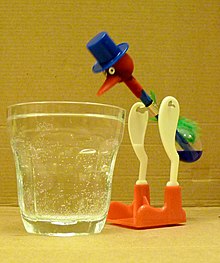Drinking bird
| Drinking bird | |
|---|---|

Drinking bird about to dip its beak in the water
|
|
| Classification | Heat engines |
| Application | Toy, Scientific demonstration |
| Fuel source | Heat transfer |
| Components | Bulbs, Tube, Axle, Support |
| Inventor | Miles V. Sullivan / Chinese Craftspeople |
| Invented | 1945 / much earlier than 1920 |
Drinking birds, also known as insatiable birdies or dipping birds, are toy heat engines that mimic the motions of a bird drinking from a water source. They are sometimes incorrectly considered examples of a perpetual motion device.
A drinking bird consists of two glass bulbs joined by a glass tube (the bird's neck). The tube extends nearly all the way into the bottom bulb, and attaches to the top bulb but does not extend into it. The space inside the bird contains a fluid, usually colored. The fluid is typically dichloromethane, also known as methylene chloride. Earlier versions contained trichlorofluoromethane. Miles V. Sullivan's 1945 patent suggested ether, alcohol, carbon tetrachloride, or chloroform.
Air is removed from the apparatus during manufacture, so the space inside the body is filled by vapor evaporated from the fluid. The upper bulb has a "beak" attached which, along with the head, is covered in a felt-like material. The bird is typically decorated with paper eyes, a plastic top hat, and one or more tail feathers. The whole setup pivots on an adjustable crosspiece attached to the neck.
Despite the drinking bird's appearance and classification as a toy, some safety considerations additional to the potential danger of thin shards of glass apply should the bulb break. Early models were often filled with highly flammable substances, though the fluid in later versions is nonflammable. Dichloromethane can irritate the skin on contact and the lungs if inhaled. It may be dangerous to people with pre-existing heart, liver, or nervous system conditions and is a suspected carcinogen.
The drinking bird is a heat engine that exploits a temperature difference to convert heat energy to a pressure difference within the device, and performs mechanical work. Like all heat engines, the drinking bird works through a thermodynamic cycle. The initial state of the system is a bird with a wet head oriented vertically.
The process operates as follows:
...
Wikipedia
